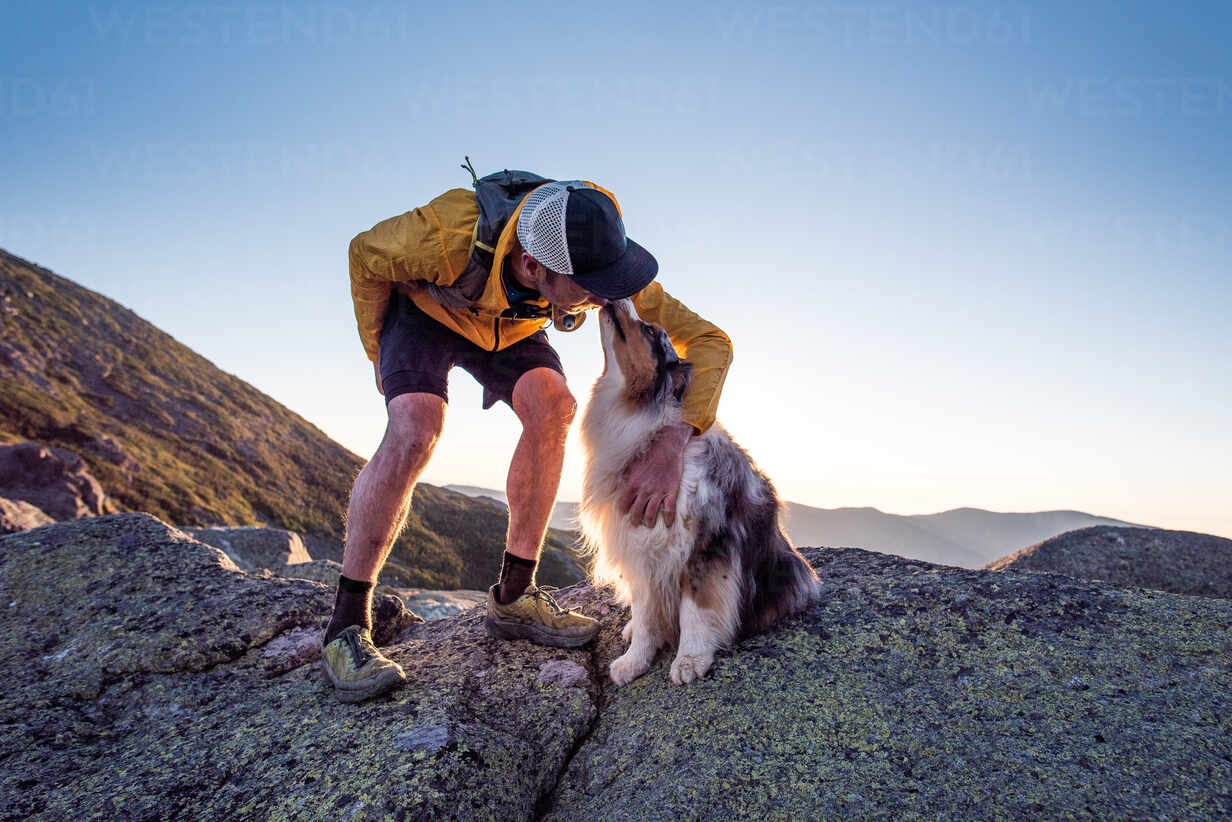Trail Running with Your Dog - The Ultimate Guide
Taking your dog on a run can be a great adventure. Imagine trail running with a cute furry sidekick jumping along the trails beside you - no doubt you’ve found your perfect trail running partner.
Trail running with your dog can be a great way to give your dog a quality workout while you are already enjoying an amazing trail run. This can also help you develop an exceptional bond with your dog out in nature and create special and adventurous memories.
TRAIL RUNNING WITH YOUR DOGHere are the 4 important things you need to know before you start trail running with your dog
|
Note: This article will primarily focus on your dog’s needs and WE ASSUME that you are already an advanced or expert trail runner. If you are a trail running beginner, we recommend developing your trail running skills before you start running with your pet.

Preparing Your Dog for a Trail Running - All You Need to Know
It is very crucial to consider your dog’s build, age, endurance, and fitness level before you plan to run with your dog. It is important for you to know if your dog is physically capable and ready for trails without putting them at any risk.
Consult a Vet
While there are certain breeds of dogs that are more physical and athletic, other breeds of dogs can run with you after a good checkup at the vet. Consulting a Vet can help you understand if your dog is ready to run with you on trails. It is very important that learn about the fitness level of your dog so that your dog does not have any risk factors or underlying conditions that may occur while trail running
Your vet can also help you to answer some other important questions that we have listed below
Does My Dog Need any Preventative Medicines or Specific Vaccinations?
The vet might recommend certain preventative medications which can be important for your dogs if you are taking them on trails. You don't have to worry much when you are running with a dog in your own block or inside the city. But, in remote areas, you may have to worry about many other things such as ticks, fleas, or heartworms that can be easily picked up by your dog while out on the trails. Your dog can also be exposed to Leptospirosis which can be found most commonly in the lake water, pond, or puddle that might've been contaminated by an infected animal.
Don't forget to ask your vet about other potential risks to your dog based on your area or trail area and take certain preventative measures to avoid them
How Far Can My Dog Run?
While the average dog with a normal medical condition can run anywhere between two and five miles. Your vet would be able to suggest the maximum distance as well the maximum running time depending on your dog's fitness level.
How to Build My Dog's Stamina and Endurance?
Just like us, your dog needs good training and enough practice to be an expert trail running dog. It’s not good for your dog’s health to handle long, hilly, tough, and most importantly new and unknown trails before you build up sufficient physical endurance level.Even if you regularly run with your dog in the city (road running with dog), as we trail runners well know, dog running on trails can be much more intense and brutal. Trail running requires different muscles than road running, which is also the same with your dog and you must train your dog up to a certain level until your dog is ready to run with you on trails.
The vet can also advise on how to train your dog to achieve your short-term and long-term fitness goals. You can work on a training schedule and exercises to build your dog’s endurance gradually.
Can I Run with My Puppy?
Trail running is certainly not safe for puppies because their bones are still growing. Trail running can be intense which is far more difficult than normal running. For most breeds, It is better to wait until they are about 1.5 years old and their bones are done developing.
Certain breeds of dogs have more physical personalities that can take to running more than the other breeds at a younger age. Therefore, Your dog’s vet can also give you better advice on when is suitable to start running with your puppy or a young dog.

Dog Running Gears Checklist - Gearing Up Your Dog for Trail Running
You might need some extra dog running gears that can be a small add-on to your existing trail running checklist. Trail running with your dog requires some high-calorie dog snacks, extra water, and some essential dog trail running gear.
Most of your dog’s everyday gear can be enough for trail running with your dog, however, dedicated dog running gear that is specifically designed to be used for hiking or running on trails have certain advantages over regular dog running gears.
The following list of gear is all those that we consider being the essential dog running gear for trail running in particular.
Trail Running Dog Leash
A trail running dog leash is the most important dog gear for trail running. A hand-free waist-attached leash is a great option to consider when it comes to dog running leashes. It’s more secure and comfortable to run with a dog as compared to a handheld dog leash. Some dog leashes can be easily converted into a waist belt for running with a dog
Dog Harness for Trail Running
A dog harness for trail running is generally a better and more comfortable option than a collar. Trails can be a difficult terrain due to many reasons where you (or your dog) may have the risk of slipping or having to stop suddenly. A harness can provide extra safety, as you don’t want to accidentally choke your dog or hurt your dog’s neck.
A trail running dog harness can be attached securely allowing you to effectively control your dog. It is also recommended to get a harness that comes with a close-to-dog handle that provides an extra added control for dicey situations such as passing a cliff edge or escaping a wet/slippery/muddy area.

GPS Dog Collar
Another important dog trail running gear is to track your dog’s location and steps. A GPS dog collar can be a bit pricey addition to your trail running checklist, but we strongly recommend getting your dog a GPS collar if you are planning to start trail running with your dog – and especially if you are planning to let your dog go off-leash (of course, in approved off-leash areas) – A GPS dog collars can be a lifesaver in a possible situation them getting lost or hurt.
Tracking your dog’s step count and fitness level is equally important for a few reasons – Most importantly to avoid over-training your dog. Your vet can give you certain important insights on heart rates, distance, and calories that are crucial for you to provide your dog with sufficient rest, water, and snacks.
Poop Bags
Even when you are out in the wild, the rule of picking up your dog’s poop remains the same. Respect nature as well as other trail users and leave no trace behind, so always pick up and pack out your dog’s waste, and don't forget to carry enough waste bags before you go trail running with your dog.
Water Bowl or Container
Just like you, your dog needs to stay hydrated during the trail run. Your dog will most certainly drink a lot more water than you do when you take them out for running, especially on a hot and sunny day. Apart from a plenty amount of water, you are also going to a collapsible or folding water bowl.
Don't forget to carry enough water for both of you before you go trail running with your dog. We strongly recommend getting a good running hydration pack that can carry enough water bottles/flasks or a water bladder with enough water storage (volume).
A hydration pack also has plenty of storage space (pockets) for other important stuff and accessories that you and your dog may need while running – such as poo bags and waste, dog snacks, trail running nutrition for intervals, first aid kits, and much more.
Here is our comprehensive buying guide on How to Choose a Running Hydration Backpack?
Dog Booties for Running
Many dogs can easily run “barefoot” but trail terrain can often be a bit harsh and difficult for some cute and soft paws. A set of dog booties designed for running can offer extra protection from sharp objects such as rocks, thorns, and snow. Moreover, dog running booties can also provide an extra grip and warmth (in snowy areas).
Don't forget to train your if they are new to booties as the dogs need some time to break in new footwear, just like us. Make sure they get used to wearing it at all. If your dog booties are chafe, buy liner socks for extra protection.

The Best Technique to Run with Your Dog on Trails
The best way to run with a dog on trails will completely depend on you and your dog. The type of trails you mostly run with your dog and your personal dog running experience will also play an important role in determining the most suitable technique for trail running with a dog.
The most practical trail running technique is to make your dog run in front of you, which most dogs naturally love to do anyway. The biggest advantage for you with this running technique is that you have constant attention to your dog. Another great advantage is that you can avoid putting a lot of pressure on your dog’s leash, and you can command him to come back and heel anytime he wants.
You can try to work on your dog's discipline to the point where your dog would run without pulling, especially on trails where sudden pulling can prove to be dangerous for you. You can also teach him the commands to “stay close” and “slow”, which allows your dog to walk or run near you, but no further than a given distance which is equivalent to the end of the leash.
It is also possible to train your dog to run behind you. The advantage of this dog running technique is that you are more likely to encounter obstacles such as animals, people, or plants on the trail. The only disadvantage of this dog running technique is that you don’t have your eye on your dog, therefore, using a dog leash is highly recommended with this way to run with your dog.
How to Trail Run With Your Dog?
Most trail runners prefer to attach their dog’s leash to their body in a “Canicross Style”, either using a dog leash that is designed to go around your waist or by using a waist belt for dog-running that connects to a bungee leash. This method is the best way to run with your dog on most terrains because it allows you to run with your dog hands-free, and you can also take the advantage of the “dog power” for your uphill climbs. And better watch out during those downhill runs!!
Trail Rules for Dog Running
Before you plan a trail running with a dog, do your homework on the trail ahead of time. Generally, dogs aren’t allowed on the national park trails, while many national forests, as well as state and local parks may have a strict on-leash rule, though the rules may vary.
Only in very rare circumstances, a trail may allow off-leash dogs, but I recommend using a leash anyway. Various hazards can suddenly appear, especially on trails and animals are too tempting to chase and create unnecessary trouble. A well-leashed dog is much safer while trail running.
|
Follow these 5 important rules when trail running with your dog:
|

Trail Hazards for Dogs
Your dog is exposed to the same dangers you are, but there are two major differences:
- Your dog can’t analyse potential hazards.
- Your dog can’t tell you about injuries or fatigue.
Therefore, you have to be extra attentive and careful of the following trail hazards for dogs
Dog Fatigues and Over-training
Observe carefully how quickly your dog is breathing and constantly monitor your dog’s heart rate. Also, observe the time your dog is taking to normalise the beating and heart rate during the breaks. If your dog is taking excessive time to normalise, take breaks more often and shorten your runs.
Wildlife
Your dog’s leash is the best protection against a foolish dash toward prickly critters like Echidnas, or larger hopping Marsupials like Kangaroos. I recommend getting your dog checked timely for other smaller pests like fleas or ticks if you regularly go trail running with your dog.
Wild Plants
Dogs often try to eat or chew on random plants, leaves, or grass, and the best approach is to stop your dog from chewing immediately. Well, not all plants are harmless and cause various health issues such as diarrhoea or dehydration.
Many plants such as poison oak, nettles, ivy, and sumac, can also cause mild discomfort for a few hours such as skin rashes on dogs.Various thorns and burrs can cause injury and discomfort, especially the paws which can completely ruin your trail running experience with your dog. Foxtails that are found on a variety of grasses during the spring and summer seasons, these barbed seedpods are more serious and won’t let go once they hitch a ride. They can be found in several places including fur, between toes, and in more sensitive areas like ears, eyes, nasal passages, and genitals.
Heatstroke
Remember, the dogs can only sweat through their paw pads, so the body takes a bit longer time to cool down. Be conservative—some dog owners and runners won’t go on a run with their dog if the thermometer climbs above 70 degrees Fahrenheit. Understand your dog and consult your vet to know what temperature is too high for your dog to run.
Note: If your dog keeps lying down in shady spots during a trail running more than usual, stop right there and carry your dog back home because excess fatigue is the first sign of heatstroke. If you see any further symptoms such as vomiting, and diarrhoea, you can cool your dog with water and a fan, then rush straight to a vet.
Waterborne Pathogens
Many trail runners and pet owners allow their dogs to drink from water natural water sources along the trails, dogs are sensitive to most of the same water-borne pathogens just like humans. It is better to carry enough clean water for both you and your dog. I recommend using hydration packs that offer enough water storage (reservoir capacity) and storage space for other dog running gears and accessories.
|
|
AuthorMohammad Humaid
Humaid is an hardcore adventurer and his most favourite adventure partner is his dog KooKoo. Mo’s favourite things includes motorbike rides, scuba diving (certified dive master), BBQ, nature photography, and blogging. Mo is a digital nomad and digital marketing is his gig. Mo loves to travel and explore new places, cultures, food, learn languages, and and ever ready to grab a coffee 24/7. His holiday destination is Santorini, Greece. He is fluent in English, German, Hindi, Urdu, and learning Russian. |










